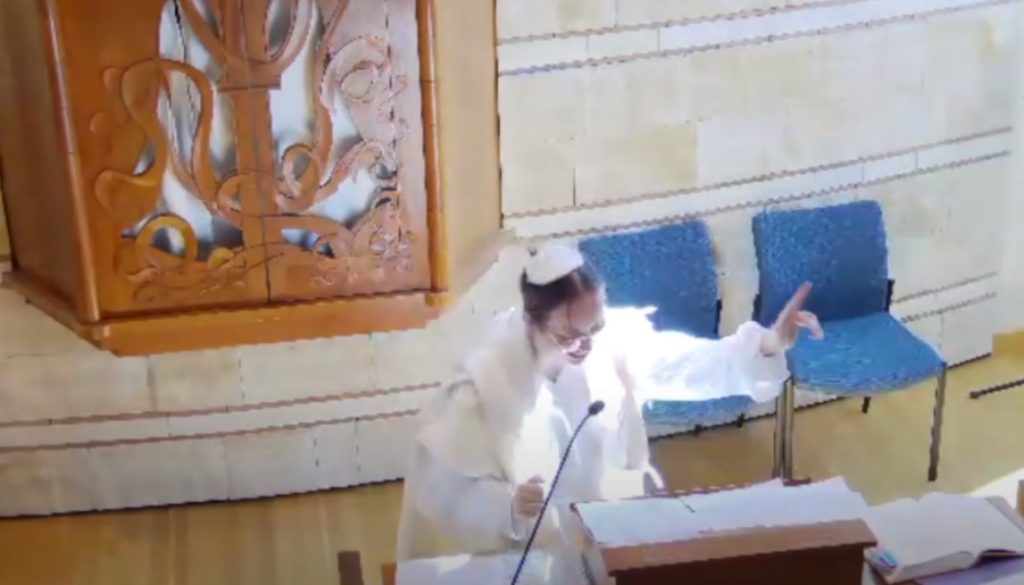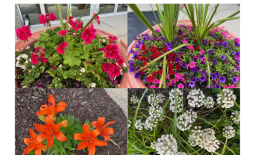Yom Kippur Shacharit Sermon 5784
I dedicate this sermon to the blessed memory of Ha’Rav Shimon Shlomo ben Avraham v’Toiba – Rabbi Stephen C. Lerner, zichrono livrachah.[1]
***
‘Come on, you gotta haggle, like Abraham. Aren’t you going to push back at me bit?’
I sat across from the rabbi across the table; he was in his mid-sixties or so, with thick-rimmed glasses and a short, scratchy beard. His East Coast inflection was unmistakable.
‘Well, I don’t know… I am uncomfortable with that.’ I softly responded.
I was a poor graduate student from Europe, fresh off the boat. It was the winter of 2004 and I was doing sociological fieldwork in New York City. But I also came for a personal mission: to convert to Judaism.
‘Okay’ he sighed, feigning righteous indignation in true Abrahamic fashion, as he lowered his tuition fee bid a last time. ‘Do we have a deal?’
I gratefully shook his hand. ‘We have a deal.’
Rabbi Stephen C. Lerner became my teacher, my mentor and my valued spiritual guide as we embarked on our journey together.
We met in a classroom at the Society for the Advancement of Judaism, the flagship synagogue of Rabbi Mordecai Kaplan, the founder of the Reconstructionist denomination. Through Rabbi Lerner, I was ushered into the world of observant-egalitarian New York Judaism. His wife was an esteemed professor and scholar at the Jewish Theological Seminary; one of his sons (still) a rabbi.
In his own brusque, New York way, he saw my potential and he pushed me. Rabbi Lerner demanded an unwavering commitment to mitzvot, intellectual excellence and emotional honesty from me. He encouraged me to be unflinchingly observant and staunchly egalitarian.
We would meet, him carrying a plastic baggie with New York bagels, munching on them during our sessions where we discussed a broad range of topics, from Jewish mysticism to modernity.
He had an unassuming manner and little did I know at the time what a ‘gadol’ – great man – he was. In the 1960’s, he protested the Vietnam war; in the 1970’s, he pushed his Conservative synagogue to become gender egalitarian—way ahead of his time. He also argued for the inclusion of gay and lesbian Jews in the Conservative movement. In the 1980’s, he founded his own well-respected conversion institute, ‘The Center for Conversion to Judaism’, at a time when this was innovative. He lifted me up and gave me my Jewish voice.
When my mikveh and Beit Din date drew near, he hosted me for Shabbat dinner at his family home in Teaneck, New Jersey. I felt honored but not without some trepidation. He was a ‘foodie’ and fed me his classic cholent recipe. I was content to bask in the glow of his family’s Yiddishkeit, even though he watched me chant Birkat haMazon like a hawk.
After passing the Jewish court, made up of gray bearded, very experienced rabbinic leaders—yes, they were old and male—I came out of the mikveh, hair still damp. The Beit Din was worried; how would I find a Jewish mate up to the challenge of being my partner, and they had determined that I should become a rabbi. ‘Esther, if you ever need a letter of reference for rabbinical school’, Rabbi Lerner offered, ‘you know where I am.’
To celebrate my entry into the covenant, he took me out for – you’ve guessed it: a bagel lunch.
Less than a year later, I did find my Jewish mate (the Beit Din needn’t have worried!) and once Dave and I started talking engagement and marriage, I wrote Rabbi Lerner a letter telling him that I was now building a Jewish home, including a photo of Dave and myself, which deeply moved him. When I returned to New York City with a Masorti Olami (global Conservative-Jewish) youth movement, I met him at the Manhattan JCC where we shared a strong hug, chewy bagels, memorable photos and emotional updates on our lives.
Years later, after rabbinical school in both Los Angeles and London, I would alight upon US shores again, this time as the Rabbi of Agudas Achim. After Shifra’s birth, I wrote Rabbi Lerner a letter, explaining that I was now part of the American Jewish story. I had three kinderlach with Very Jewish Names, my bashert (soulmate) beside me and my own dual-affiliate Reform-Conservative congregation. It was the fall of 2019 when I entrusted my letter to the United States Postal Service. I figured that, once Shiffie was old enough, my family could take a trip to New York and Rabbi Lerner could meet all of us.
But no response came. I wasn’t overly worried – after all, why would he want to correspond with a student from over 15 years ago? He had his own life to live.
Then a certain virus happened…
As the death rates peaked on the East Coast during that first, scary, pre-vaccine year of the pandemic, I worried for him. He was quite elderly. My days were consumed with managing the weird and warped pandemic rabbinate and taking care of my family during lock-down.
Then, I saw an announcement on Facebook from his son, my colleague.
Rabbi Stephen C. Lerner, in the early winter of 2021, has succumbed to COVID.
I was heartbroken. I felt deeply saddened that I would not get to ever meet him again, introducing him to my little tribe of Jews, Mishpachat Middleton-Hugenholtz.
Through the miracle of digital technology, I procured the Zoom link for the digital Shivah minyan and was able to attend most prayers throughout the week. Very early in the morning, I would sit on my couch, wrapped in my tallit and tefillin, davening with the small congregation online.
After davening, the family started sharing stories about Rabbi Lerner’s menschlike life. It was through this sharing that I learned an incredible fact about my teacher: he had studied ancient history at the University of Iowa!
It was here that he met Rabbi Abraham Joshua Heschel, whom he chaperoned on a speaking tour (I have a fantasy that Rabbi Heschel and Stephen Lerner walked across the Pentacrest together). Rabbi Heschel spoke deeply to Stephen Lerner’s soul, prompting a religious revival in the young Lerner, culminating in his enrolment at the Jewish Theological Seminary.
When I heard this, I think my eyes almost popped out of my head. As the family encouraged others to share, I told them Rabbi Lerner had made me Jewish and I had been on a long and meandering journey across oceans and continents, finally becoming a rabbi in… Iowa City.
This truly seemed the working definition of synchronicity.
‘Dr. Lapidus’, I asked his wife gently. ‘A while ago, I sent Rabbi Lerner a letter updating him on my life. Did he ever get it?’
She looked at me, remembering me. ‘It is good to have you here, Esther. Ah, the letter’, she remarked. ‘You know what happened? The address you put on it was out of date. We’d moved house. For many months, it was displaced by US Mail before being delivered. He read it a few weeks before his death and he was so happy to hear from you.’
My heart was aflutter and then found itself at peace.
Rabbi Lerner would be honored and loved among his family, friends, colleagues, the JTS community and the 1800 souls he brought under the wings of the Divine Presence. His legacy is a cherished and enduring one.
Legacy. Heritage. In Hebrew, Yerusha. ‘U’mah jafah yerushateinu’ – ‘and how beautiful is our heritage.’
In Rabbinic Judaism, we treasure and value our teachers, sitting metaphorically at their feet. Throughout my Jewish life, I have so many invaluable teachers. Pirkei Avot, the Rabbinic sayings of the Mishnah, teaches us: ‘Aseh lecha rav, k’ne lecha chaver’—‘make for yourself a teacher, acquire for yourself a friend.’[2]
My beloved teacher was cruelly taken by COVID, but his legacy endures. He taught me Jewish grit, humor and passion, a constancy in the observance of our holy Torah and the value of advocating on behalf of those marginalized in the Jewish tradition. He helped open the gates in the Conservative movement. His Jewish joy was sharing the gift of Torah with others as it was shared with him.
I invite us to contemplate the mentors in our own life. Perhaps this was a school teacher or a kindly neighbor, a wise friend or relative, an encouraging and empowering university professor, an insightful therapist or intuitive co-worker. Our own children or grandchildren can be our teachers.
Who are those who have opened doors for us? Gates of welcome and belonging, gates of wisdom and learning. Gates of spirit and love.
We may remember them in tender moments, or through the flickering flame of our Yahrtzeit candles. Another link in the chain of tradition, their legacy becomes our beautiful heritage.
In a fast-paced world, so much that we create or inhabit can seem fleeting: ‘like fading grass’ as the Unetaneh Tokef prayer expresses it. Yet legacies are enduring.
When I look at this congregation – I look out at all of you, your divine souls – I marvel at what a beautiful legacy we are continuing to build here. Agudas Achim was founded in 1916 – we are now in our second century. This congregation has outlived various iterations of buildings and has been honored to have had one of the longest-serving rabbis in the Reform rabbinate – our own beloved Emeritus Rabbi, Rabbi Jeff. (Rabbi Jeff’s ‘career lasted longer than Moses’s!’) Through transition and change, this congregation has continued to go from strength to strength.
This is the moment for us to take stock of our collective legacy.
We inhabit this elegant, efficient building.
I love how the light filters through the windows, the warmth of the wooden floor, the evocative curvature of the ark. I love the bouncy laughter of our Sunday School children as they dart through the hallways and the joyous blending of our voices in worship and song.
We also inhabit this beautiful town. A synagogue is more than its four walls; we experience it wherever we let the light of Torah shine. We bring our values and spirituality to the marketplace of ideas, to the streets, the cafes and the public library. That too, is our legacy. Mah yafah yerushateinu – how beautiful our heritage.
It is my prayer that we continue to build our legacy at Agudas Achim; spiritually, socially, practically and financially. Last year, we were facing a projected deficit, but thanks to increased dues and affiliation, this has been resolved. This alone is an impressive feat in a time of economic uncertainty. I am deeply grateful to you all for the many ways you give to our community.
Likewise, it is both a great and generous gift and a smart, forward-looking strategy that we do not ask for High Holiday tickets. Your big-hearted donations allow us to continue our warm welcome and if you haven’t pledged to our High Holiday fundraiser, please consider donating so that we can continue our holy work.
No legacy can endure without a profound and abiding sense of joy.
As we remember our teachers who have gone before us, we honor the noble heritage they have bequeathed upon us. And as we seek to transmit this legacy, l’dor vador, from generation to generation, we know that it is neither guilt nor nostalgia that will help us pass on our Judaism in the 58th century.
Rather, it is both falling in love and filling ourselves up with Judaism that is the best guarantor of our continuity.
As I look back on my own transformative mentors, three rabbis have guided my path,: Rabbi Alexander Schindler, Rabbi Leo Baeck and my teacher Rabbi Stephen C Lerner.
Rabbi Alexander Schindler was a German born Reform rabbi who became the President of the Union of American Hebrew Congregations (later, Union for Reform Judaism) and held that post for over two decades. Through his unabated energy to create the Reform Movement’s ‘Outreach Program’ in the 1980’s, he opened the doors for many.
Rabbi Leo Baeck, a German Reform rabbi who survived the Sho’ah, was the namesake of my ordaining seminary in London, Leo Baeck College. Baeck, addressing the World Union for Progressive Judaism in 1949, argued that that it is our mission to to share Jewish wisdom and ethics and ‘fill Jews with Judaism’ so that we might share and build and increase Jewish joy.
Rabbi Lerner was such a Jew filled with Judaism, so much so that it spilled over and took root in the souls of his students. His New York ‘Center for Conversion to Judaism’ still exists and is headed by a friend and colleague of mine, another convert-rabbi.
In my own way, out here in Iowa City, I am honored to carry on Rabbi Lerner’s work and legacy. I bless all of us this Yom Kippur to continue building our beautiful legacies in our lives; in our hearts and in our homes, in our workplaces and our marketplaces, in the synagogue and between each other.
I invite all of us to think of a concrete way in which we can build our Jewish legacies, one mitzvah – one good deed – at a time.
May yafah yerushateinu – may the beauty of our Jewish heritage continue to light our eyes and the path of our feet.
How fortunate are we – Ashreinu.
[1] For more biographical information on Rabbi Stephen C. Lerner, see his obituary https://www.legacy.com/us/obituaries/nytimes/name/stephen-lerner-obituary?pid=197625338
[2] Mishnah Avot 1:6





